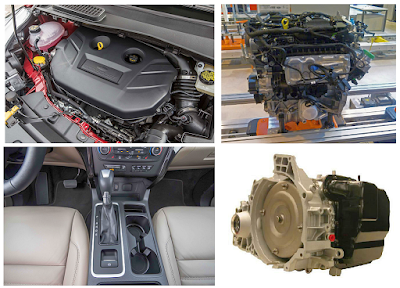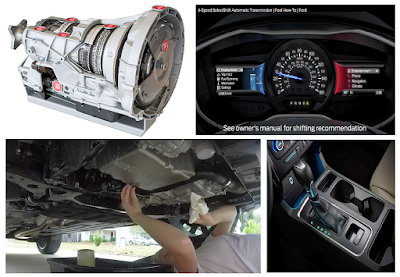2017 Ford Escape Engines and Transmission
2017 Ford Escape comes with the new engine option which is a nice evolution of Ford’s SUV. Sadly, this development adds only a small improvement to the more excellent into 2018 Ford Escape.However, seemingly smaller tech changes make a much more substantial impact on the latest Escape. A few of the minor tech changes on the 2017 Ford Escape are Sync Connect, Android Auto, CarPlay and also a few driver aid features. Those are the stuff that makes the 2017 Ford Escape feels like a brand new car with just some changes on its engine and tech. That’s why we brought you this in-depth view about new Ford Escape engine and transmission.
2017 Ford Escape Engine Bay
The latest model of Ford Escape comes with the last year’s base 2.5-liter naturally aspirated engine and with the 2.0-liter turbocharged Ecoboost engines persist. This larger engine that is available is good for 168 horsepower and also 170 pound-feet of torque. The 2.0-liter turbocharged also gets a 5 horsepower boost, to 275, and a 5 pound-feet torque boost, to the 245. If we compare it to the numbers of its competitors, those are pretty big for a small SUV like Ford Escape. It can be something to consider especially if you frequently fill all the seats, pull a trainer, or carry cargo with your SUV.
EcoBoost-equipped engines are specifically designed to deliver horsepower and torque consistent because of its larger-displacement (cylinder volume) that is the naturally aspirated engine which is claimed by Ford can achieve approximately 30% better fuel efficiency and also 15% fewer greenhouse emissions. The turbocharged engine means an engine that uses a device that forces in more air than a normal one would receive. That’s why Ford Escape is promising engine options to be as powerful as you’ve ever wanted.
New 1.5-L Ecoboost engine
On the latest Ford Escape, there is a new 1.5-liter Ecoboost option in the middle which is a tiny and turbocharged four-cylinder engine mated to a six-speed automatic transmission. There are two available options: with front-wheel drive or on-demand all-wheel-drive configurations. It is even a pint-sized power plant for a small SUV like Ford Escape, but with 179 boosted horsepower and also 177 pound-feet of torque, it is just a bit more powerful than Ford’s 2.5-liter engines. The downsizing the engine on the 2017 Ford Escape is aimed to net fuel efficiency gains. We can take an example of the 24 combined mpg (22 mpg city, 28 mpg highway) which is tested for the all-wheel-drive version, the 1.5-liter Ecoboost engine of the latest Escape is the most efficient model in Ford’s lineup.
2017 Ford Escape Engine
Advertisement
2.0 l 4-cylinder
2.5 l 4-cylinder (s)
1.5 l 4-cylinder
2017 Ford Escape Transmission
As the best two four-cylinder engines runing with turbocharged, the new Ford Escape 2017 give you a special transmission
6-speed automatic with manual
Power: 179 hp @ 6000 rpm
Zero to 60 mph: 9.2 sec
Torque: 177 lb-ft @ 2500 rpm
The smaller Ecoboost engine of the newest Escape is also a good enough powertrain, which is delivering a decent performance around the town and on the highway as well. Ford, on the latest Escape, implements idle-stop to help you save fuel which automatically shuts down the engine at stop lights. It is not the only thing about the 2017 Escape feature to be praised; you’d be probably more excited to know that when you lifted a foot from the brake, the car quietly brought the engine back to life.
Understanding the Positions of Your Ford Automatic Transmission
Putting your vehicle in gear:
1. Fully press down the brake pedal.
2. Press and hold the button on the front of the gearshift lever.
3. Move the gearshift lever into the desired gear.
4. Release the button and your transmission will remain in the selected gear.
Park (P)
This position locks the transmission and prevents the wheels from turning.
Reverse (R)
With the gearshift lever in reverse (R), your vehicle will move backward. Always come to a complete stop before shifting into and out of reverse (R).
Neutral (N)
With the gearshift lever in neutral (N), your vehicle can be started and is free to roll.
Hold the brake pedal down while in this position.
Drive (D)
Drive (D) is the normal driving position for the best fuel economy. The overdrive function allows automatic upshifts and downshifts through gears one through six.
Sport (S)
Moving the gearshift lever to sport (S):
- Provides additional grade (engine) braking and extends lower gear operation to enhance performance for uphill climbs, hilly terrain or mountainous areas. This will increase engine RPM during engine braking.
- Provides additional lower gear operation through the automatic transmission shift strategy.
- Gears are selected more quickly and at higher engine speeds.
- Press the transmission control switch on the side of the gearshift lever to activate grade assist.
- Provides additional grade braking with a combination of engine motoring and high-voltage battery charging to help maintain vehicle speed when descending a grade.
- As your vehicle determines the amount of engine motoring and high-voltage battery charging, you may notice the engine speed increasing and decreasing to help maintain your vehicle speed when descending a grade.
- The grade assist lamp in the instrument cluster is illuminated.
The grade assist lamp will appear in the instrument cluster when grade assist is turned on.
Press the transmission control switch again to return to drive (D).
SelectShift Automatic Transmission
Your SelectShift automatic transmission gives you the ability to manually change gears.
If equipped with a toggle on the gearshift lever:
• Press the (+) button to upshift.
• Press the (-) button to downshift.
If equipped with steering wheel paddles:
• Pull the right paddle (+) to upshift.
• Pull the left paddle (-) to downshift.
With your vehicle in drive (D), the paddle shifters provide temporary manual control. They allow you the ability to shift gears quickly, without taking your hands off the steering wheel. You can achieve extensive manual control by moving the gearshift lever to sport (S). The system determines when temporary manual control is no longer in use and returns to automatic control.
Recommended Shift Speeds
Upshift to the recommended shift speeds according to the following chart:
Upshifts when accelerating (recommended for best fuel economy) Shift from:
1 - 2 15 mph (24 km/h)
2 - 3 25 mph (40 km/h)
3 - 4 40 mph (64 km/h)
4 - 5 45 mph (72 km/h)
5 - 6 50 mph (80 km/h)
The instrument cluster will display the selected gear that you are currently in and a shift indicator arrow to assist in optimizing shifting.
Select Shift will automatically make some shifts for you in the event that your engine speed is running at too high, or too low an RPM.
Note: Engine damage may occur if excessive engine revving is held without shifting.
WARNINGS
Do not drive your vehicle until you verify that the brake lamps are working. When doing this procedure, you will be taking the vehicle out of park which means the vehicle can roll freely. To avoid unwanted vehicle movement, always fully set the parking brake prior to doing this procedure. Use wheel chocks if appropriate.
If the parking brake is fully released, but the brake warning lamp remains illuminated, the brakes may not be working properly. See your authorized dealer.
Use the brake shift interlock lever to move the gearshift lever from the park position in the event of an electrical malfunction or if your vehicle has a dead battery.
Apply the parking brake and turn the ignition off before performing this procedure.
1. Insert a screwdriver (or similar tool) between the shifter bezel and the top finish panel.
2. Use the tool to unsnap the shifter bezel from the finish panel.
3. Locate the white lever located on the left side of the shifter.
4. Using the tool move the white lever towards the rear of the shifter.
5. While holding the white lever in the rear position, move the shifter from the park position.
6. Press the shifter bezel back into the top finish panel until it snaps back into position.
7. Apply the brake pedal, start the vehicle and release the parking brake.
See your authorized dealer as soon as possible if this procedure is used.
Advertisement
If we watch on Ford’s advertising around the EcoBoost brand, you might expect the 2017 Escape’s duo of the turbocharged engine to deliver the excellent fuel economy as it is supposed to be. In fact, you won’t get all of the expected stuff to happen because the EcoBoost engines are less about Eco, but it is more about Boost, and they are utilizing their turbochargers to improve power rather than stretch fuel. Ford Escape is apparently not the only compact crossover which has small turbocharged engines under the hood as we can find it, too, under the hoods of almost all cars in the same class for the same reason that is to boost powerplants that delivers the best fuel-economy numbers.
If Your Ford's Gets Stuck In Mud or Snow Follow this tutorial:
Do not rock the vehicle if the engine is not at normal operating temperature or damage to the transmission may occur.
Do not rock the vehicle for more than a minute or damage to the transmission and tires may occur, or the engine may overheat make an bad or empty oil.
If your vehicle gets stuck in mud or snow, it may be rocked out by shifting between forward and reverse gears, stopping between shifts in a steady pattern. Press lightly on the accelerator in each gear. Advertisement


